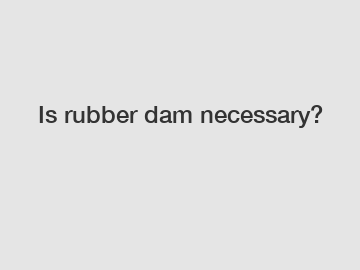Is rubber dam necessary?
Is rubber dam necessary?
The use of a rubber dam during dental procedures is a long-standing practice. It has been considered an essential tool to isolate the teeth being worked on and create a clean and dry environment. However, with advancements in dental techniques and materials, the necessity of using a rubber dam has sparked debates among dental professionals. Is the rubber dam truly necessary? Let's explore this question and examine the pros and cons.
1. Infection control: One of the primary reasons for using a rubber dam is to prevent contamination and infection. By isolating the treatment area, this thin sheet of latex or non-latex material provides a barrier that minimizes the spread of saliva, blood, and microorganisms. This is crucial, especially during procedures that involve drilling or scaling, which can generate aerosols potentially carrying bacteria or viruses.

2. Enhanced visibility: Another advantage of using a rubber dam is that it improves the visibility for both the dentist and the patient. By keeping the working area dry, the dentist can clearly see the tooth surface, ensuring precise and accurate treatments. Additionally, patients often appreciate the enhanced visibility as it allows them to understand the procedure better and feel more reassured.
3. Soft tissue protection: When performing certain dental procedures, such as applying adhesive or bleaching agents, the surrounding soft tissues need protection. The rubber dam acts as a shield, preventing contact between the materials and the gums, cheeks, or tongue. This reduces the risk of irritation, chemical burns, or allergic reactions.
4. Patient comfort: While some patients find the placement of a rubber dam uncomfortable, others experience increased comfort during dental procedures. It prevents accidental contact with sensitive or exposed nerves, reducing sensitivity and discomfort. Moreover, the rubber dam serves as a physical barrier, preventing instruments or materials from accidentally entering the oral cavity, resulting in a more relaxed experience for the patient.
Considering these points, it becomes evident that there are numerous advantages to using a rubber dam during dental procedures. The infection control, enhanced visibility, soft tissue protection, and patient comfort it provides are valuable aspects of modern dentistry. However, it's essential to acknowledge the opposing arguments and explore potential drawbacks.
1. Time-consuming: One criticism of using a rubber dam is that it can extend the duration of dental procedures. The placement and removal of the dam add extra steps that may prolong the overall treatment time. This can be a concern for both the dental professional and the patient, particularly in cases where efficiency is crucial.
2. Sensory discomfort: Some patients may experience sensory discomfort due to the placement of a rubber dam. The stretchy material and the presence of a foreign object in the mouth can cause feelings of claustrophobia or anxiety. Additionally, patients with a strong gag reflex may find it challenging to tolerate the pressure of the dam on their oral tissues.
3. Limited accessibility: In certain situations, such as complex restorative cases or when working with pediatric patients, the use of a rubber dam may impede access to the treatment area. The dam's placement restricts visibility and can make it more difficult to maneuver dental instruments, potentially affecting the quality of the final result.
4. Alternative techniques: With advances in dental technology, alternative techniques have emerged that aim to achieve similar outcomes as the rubber dam. For example, dental isolation systems that use suction, such as the Isolite or DryShield, can provide moisture control and create a clean field without the need for a rubber dam. These newer techniques offer convenience and potentially reduce patient discomfort associated with traditional rubber dam use.
In conclusion, while the use of a rubber dam has long been a standard practice in dentistry, its necessity is a topic that sparks controversial discussions. The advantages it brings in terms of infection control, enhanced visibility, soft tissue protection, and patient comfort cannot be denied. However, it's essential to acknowledge the concerns regarding its time-consuming nature, sensory discomfort, limited accessibility, and the emergence of alternative techniques.
Ultimately, the decision to use a rubber dam should be made on a case-by-case basis. Dental professionals must consider the specific needs of each patient, the procedure being performed, and the available alternatives. By continuously evaluating new technologies and techniques, dentists can adapt their practices to provide the best possible care for their patients while ensuring patient comfort, safety, and optimal treatment outcomes.
Want more information on Environmental Protection Inflatable Rubber Dam, custom hydraulic elevator dam, remote control hydraulic dam? Feel free to contact us.
136
0
0


Comments
All Comments (0)